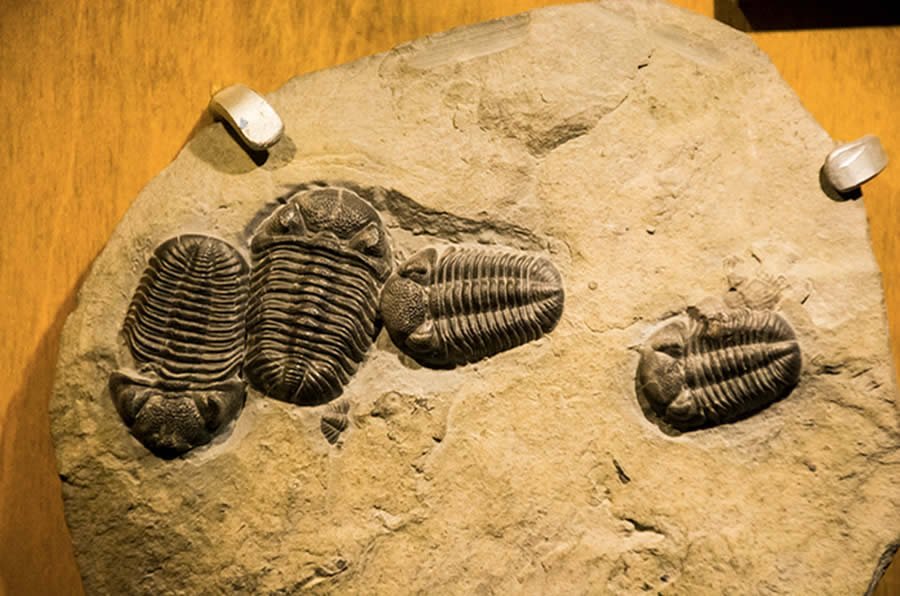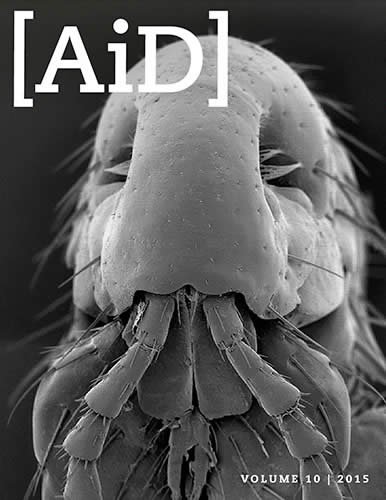
Bigger Marine Animals Favored by Evolution?
News to Know
Abstract
Evolutionists say they have confirmed that “Cope’s rule” ruled in the evolution of marine animals.
News Sources:
- BBC News, “Evolution ‘Favours Bigger Sea Creatures’”
- Stanford News Service, “Animals Tend to Evolve Toward Larger Sizes Over Time, Stanford Study Finds”
Do animals evolve to become bigger and bigger over time? The largest fossilized animal in the Cambrian explosion was the trilobite, dated at 542 million years and topping out at about a foot-and-a-half in length. Can the evolutionary advantages of being bigger explain how the world’s largest animal—the blue whale—evolved to be 100,000 times larger than the largest trilobite? Stanford University evolutionary scientists answer “yes” to both of these questions, at least for marine animals.
Stanford paleobiologist Jonathan Payne and colleagues base their conclusions on a statistical survey of the body sizes of over 17,000 kinds of animals. His team reports that the average size of marine animals increased more than 150-fold over the past 542 million years. Most of the size increase, statistically speaking, was due to an increase in the maximum size of fossils in each layer ascending from the Cambrian through the Pleistocene strata.1 In other words, among the marine animals surveyed, the largest animals in each fossil layer were larger than the largest in the layers below. If the fossil layers actually did represent an evolutionary timeline, then this might suggest that the record-breaking sizes marine animals could achieve got larger and larger over millions of years. (As we will point out below, the layers do not mark millions of years of elapsed time, and there is another explanation for the way these fossils stack up!)



God created marine invertebrates like these trilobites as well as “great sea creatures” (Genesis 1:21) on the same day, about 6,000 years ago. Trilobites, like many other marine invertebrates, were suddenly and catastrophically buried early in the global Flood, and therefore they dominate the deepest layers of fossil-rich sedimentary rock deposited during the Flood. Abundant in the Cambrian, they become less abundant in the Ordovician and Devonian and do not appear above the Permian. The collection of trilobites at the Creation Museum in Petersburg, Kentucky, contains many complete specimens from the Cambrian, Ordovician, and Devonian layers. The trilobite display includes many small trilobites like this group of Paciphacops raymondi from Coal County, Oklahoma’s Devonian Haragan Formation and larger specimens such as this four-inch Devonian Phacops africanus and foot-long Paradoxides from Cambrian rock. Images courtesy of Deb Minnard, Answers in Genesis/Creation Museum, Petersburg, Kentucky.
Matching the Model
The Stanford researchers tried to determine whether evolutionary advantages led to the average size increase of marine animals ascending in the fossil record. “It’s possible that as evolution proceeds, there really is no preference for being larger or smaller,” the study’s lead author Noel Heim explains. “What appears to be an increase in average body size may be due to neutral drift [random non-selective changes].”2 Therefore, they compared their collected data to a computer model of how evolution presumably should have happened if “survival of the fittest” really were a decisive boon to upscaled body size over millions of years.
They found their surveyed selections matched their evolutionary model better than a model built on random changes offering no survival advantages. “As time marches forward, each species is assigned some probability of producing a new species, of remaining the same, or of going extinct, at which point it drops out of the race,” explains Heim, adding, “The degree of increase in both mean and maximum body size just aren't well explained by neutral drift. It appears that you actually need some active evolutionary process that promotes larger sizes.”3 Though the authors can only speculate about the reasons bigger was better at promoting up-scaled evolutionary changes, they are confident that, for the majority of marine animals, it did so.
Coping with Challenges in the Big Wide World
“Our study is the most comprehensive test of Cope’s rule ever conducted,” Heim says. “Nearly 75 percent of all of marine genera in the fossil record and nearly 60 percent of all the animal genera that ever lived are included in our dataset.”4
Cope’s rule, named after American paleontologist Edwin Drinker Cope, states “that animal lineages evolve toward larger body size over time.”5 Cope’s rule was an attempt to explain a pattern in the fossil record of many kinds of terrestrial mammals. Nineteenth-century paleontologists observed that, among similar sorts of terrestrial mammals (like canines or the deer kind, for instance), fossils found in deeper fossil layers were often smaller than those found in Ice Age deposits. (Incidentally, these larger variations within some created kinds of mammals likely resulted from the selective advantages of sizing up in coping with the rapidly changing conditions of the post-Flood world. But they have nothing to do with molecules-to-man evolution.)
Efforts to apply Cope’s “rule” to other types of animals in the fossil record have met with mixed results. Animals like birds and insects have been particularly uncooperative—and all the more since many evolutionists decided birds must have evolved from dinosaurs.
Payne’s army of data collectors combed the literature collating size information about thousands of marine animals. “We've known for some time now that the largest organisms alive today are larger than the largest organisms that were alive when life originated or even when animals first evolved,” Payne told the Stanford News Service. Nevertheless, he adds, “It's not something that you can know by just studying living organisms or extrapolating from what you see over short time scales. If you do that, you will absolutely be wrong about the rate, and possibly also the direction.”
Payne and Heim contend that their study demonstrates Cope’s rule did govern the predictable evolution of marine animals in four of the five categories they examined—arthropods, brachiopods, chordates, echinoderms, and mollusks. Arthropods didn’t trend bigger up through the fossil record and in fact got smaller,6 but their failure to comply with Cope’s rule could not statistically counterbalance the cooperation of the other animals. Most of the animals surveyed were invertebrates, but among the marine vertebrates were sharks, represented by a 6-inch-long Falcetus dated at 372 million years and a modern great white shark 26 feet long.
Why might bigger be better for long term success? “We don't really have a concrete idea,”7 Heim says, but the authors do suggest bigger animals with higher metabolic rates might have been more active and therefore more successful predators. The authors also speculate that marine reptiles and marine mammals (like whales) evolved to be so big because they were able to utilize the much higher oxygen concentrations available in air.8
Remember, evolutionists believe that marine animals first evolved into land animals, and that large aquatic mammals, like air-breathing whales, evolved from land animals returning to the sea. Thus, the authors speculate that the evolved ability to breathe air—honed in land animals—served their evolutionary purposes well as they returned to the sea and evolved to enormous sizes. The operative word here is speculate: This is evolutionary story-telling at its best.
Trending Bigger?
Payne’s team assumes the fossil record is an evolutionary timeline providing a record of nearly 550 million years of evolution of life on Earth and that size therefore increased over vast oceans of time. They, of course, assign conventional evolutionary dates to the animals in the fossil record. In fact, the authors’ interpretation of the data is totally dependent on the millions-of-years timescale evolutionists assign to the fossil record. These dates are based on a number of unverifiable worldview-based assumptions. (You can review Radiometric Dating 101 in “Radiometric Dating: Back to Basics,” “Radiometric Dating: Problems with the Assumptions,” and “.”)
If, however, the fossil record on which the authors focused their attention was deposited within a very short span of time (as we contend) and does not represent millions of years of biological history, then the “trends” reported in the study—even the apparent size changes within created kinds of animals—cannot be attributed to Is Natural Selection the Same Thing as Evolution?, much less to any more imaginative trilobite-to-tiger shark sort of evolutionary scenario.
Sorting by Size, Not Survival by Size
Earth’s geologic layers, when stripped of the long-age assumptions assigned to them, provide a record consistent with the biblical history of the global Flood about 4,350 years ago and the subsequent post-catastrophic events expected in its aftermath. Furthermore, biological observations show that animals only vary within their created kinds. So what else could account for the segregation of some kinds of marine animals according to size in the fossil record?
Much of the answer to this question depends on the powerful way in which moving water sorts the objects in it. To understand why the fossils of the Cambrian explosion and subsequent layers deep in the fossil record appear, Answers in Genesis geologist Dr. Andrew Snelling explains, we must consider the hydrodynamic selectivity of moving water:
Another factor tending to ensure the deposition of the supposedly simple marine organisms in the first-deposited strata, now deep in the geologic record, is the hydrodynamic selectivity of moving water for particles of similar sizes and shapes, together with the effect of specific gravity of the respective organisms.9
The amount of drag exerted on particles in moving water is affected by their size, shape, and density. Dr. Snelling explains the result of this in his book Earth’s Catastrophic Past:
Particles in motion will tend to settle out in proportion mainly to their specific gravity (or density) and sphericity. It is significant that the marine organisms fossilized in the earliest Flood strata, such as the trilobites, brachiopods, etc., are very “streamlined” and quite dense. The shells of these and most other marine invertebrates are largely composed of calcium carbonate, calcium phosphate, and similar minerals, which are quite heavy, heavier than quartz, for example, the most common constituent of many sands and gravels. This factor alone would have exerted a highly selective sorting action, not only tending to deposit the simpler (that is, the more spherical and undifferentiated) organisms first in the sediments as they were being deposited, but also tending to segregate particles of similar sizes and shapes, which could have thus formed distinct faunal stratigraphic “horizons,” with the complexity of structure of deposited organisms, even of similar kinds, increasing progressively upwards in the accumulating sediments.10
It is quite possible that this could have been one of the major processes responsible for giving the fossil assemblages within the strata sequence a superficial appearance of “evolution” of similar organisms in the progressive succession upwards in the geologic record. Generally, the sorting action of flowing water is quite efficient, and would definitely have separated the shells and other fossils in just the fashion in which they are found, with certain fossils predominant in certain stratigraphic horizons, and the complexity of such distinctive, supposedly “index” fossils increasing in at least a general way in a progressive sequence upwards through the strata of the geologic record.11
Thus, if the sizes stack up as the researchers contend, divorced from the millions of years, the fossil record fits the model of the biblical Flood and the observable physics of moving water.
Sizing Up the Trend
But do the body sizes of marine animals even follow the trend claimed in the study? Lead author Heim admitted, “The consistent trend does not mean that every single genus of animals evolved to grow larger.”12 Furthermore, examination of the study’s supplementary materials reveals a good deal of bias in the types of animals surveyed. Dr. Snelling describes some of these biases:
First of all, the study was biased in the selection of which marine organisms were chosen—“Only solitary, bilaterian marine animals were included in the analysis.”13
This means that even though evolutionists believe all forms of life are literally related, the survey excluded animals that live in colonies—like corals—and animals like corals and sponges that have round bodies from their study. They just surveyed marine animals from a select portion of their evolutionary tree even though animals with other body plans are abundant in the fossil record. But—as Dr. Snelling also notes below—even though they excluded these broad categories of animals, they included those that are found in only a portion of the fossil record and presumptively counted other kinds of animals in higher strata as their evolutionary descendants for size comparison:
Second, the study is biased because of the nature of the fossil record in which marine creatures went extinct and so are not found uniformly through the strata sequence containing the fossil record. The most notable example is the trilobites which dominate the Cambrian (earliest early Flood strata) and then very rapidly decrease in relative abundance in the Ordovician and upwards before becoming extinct altogether at the end of the Permian.14 This means that apples are not being compared with apples, so to speak, as one progresses up the strata record; in this case trilobites lower in the strata record are being compared with gastropods (snails) and bivalves higher in the record.
Third, the study is biased because the main paper and much of the Supplementary Materials focus on genera, because they are deliberately trying to prove the supposed increase in sizes is due to evolution through time. On the other hand, we regard the genera as variations within the created kinds because the created kinds are generally at the family level.
So if there is an increase in sizes between the genera within each created kind upwards in the fossil record, this has nothing to do with evolution, but everything to do with sorting by water. But it is difficult to establish that from this study, because the raw data aren’t provided so that we can check whether within each created kind the genera do or don’t increase in size upwards in the fossil record.
Increasing size within a created kind is only variation and may be affected by natural selection, but that has nothing to do with the evolution of increasingly complex kinds of animals. Conversely, reports of increasing size through mismatched animals grouped according to their presumed evolutionary relationships illustrates nothing but the ability to spin circular reasoning into a peer-reviewed study. Matching the survey data to a computer model of evolution also fails to demonstrate that the evolution of increasingly complex kinds of animals ever happened, and even the data evaluated in the authors’ model was saddled with millions of years of evolutionary dates. The authors’ speculations concerning the return of enormously efficient air-breathing mammals to the ocean to explain the existence of large marine animals like the blue whale are again rooted in nothing more than their worldview-based faith in microbes-to-Moby Dick evolution. They would do better to have faith in the biblical record of the global Flood and to see how the fossil record stacks up against the physics of moving water and the Flood-based model of geology.
Further Reading:
- Why Were Ice Age Animals So Big?
- Canada’s New Cambrian Explosion: Burgess Shale Chapter Two
- Doesn’t the Order of Fossils in the Rock Record Favor Long Ages?
- Local Laboratory Restores Trilobite Fossils
- Trilobite Eyes—Ultimate Optics
- Fossil Evidence of Whale Evolution?
- Whale Skull Equipped for Sonar Shows Echolocation Appears Abruptly in the Fossil Record
- Ancient Whales and How Their Skulls Affected Directional Hearing
- Big Blue
For More Information: Get Answers
Remember, if you see a news story that might merit some attention, let us know about it! (Note: if the story originates from the Associated Press, FOX News, MSNBC, the New York Times, or another major national media outlet, we will most likely have already heard about it.) And thanks to all of our readers who have submitted great news tips to us. If you didn’t catch all the latest News to Know, why not take a look to see what you’ve missed?
(Please note that links will take you directly to the source. Answers in Genesis is not responsible for content on the websites to which we refer. For more information, please see our Privacy Policy.)
Footnotes
- N. Heim et al., “Cope’s Rule in the Evolution of Marine Animals,” Science 347, no. 6224 (February 20, 2015): 867- 870, 10.1126/science.1260065.
- Ker Than, “Animals Tend to Evolve Toward Larger Sizes . . .” Stanford News Service, February 19, 2015, http://news.stanford.edu/news/2015/february/body-size-evolution-021915.html.
- Ibid.
- Ibid.
- Heim et al., “Cope’s Rule in the Evolution of Marine Animals.”
- Tanya Lewis, “Shrimpy Sharks to Great Whites: Marine Animals Have Gotten Bigger Over Time,” LiveScience, February 19, 2015, http://www.livescience.com/49877-marine-animals-increasing-size.html.
- Ibid.
- The authors write, “Air breathing is an exaptation that can explain the rapid and widespread attainment of large size in marine reptiles and mammals. Relative to water, air has 20 to 30 times the concentration of O2, is up to 100 times less viscous, has diffusion rates of O2 through membranes that are 300,000 times faster, and is about 1000 times less dense. Thus, large animals are better able to meet their metabolic needs by breathing air than by breathing water. In fact, O2 limitation has been proposed as a mechanism for limiting the evolutionary emergence of large, free-swimming, predatory bilateria generally.” From Heim et al., “Cope’s Rule in the Evolution of Marine Animals.”
- Andrew Snelling, Earth’s Catastrophic Past: Geology, Creation, and the Flood (Green Forest, AR: Master Books; Petersburg, KY: Answers in Genesis, 2015) 733.
- Ibid., 733–734.
- Ibid., 734.
- Laura Clark, “The World’s Sea Creatures Have Gotten Bigger,” SmartNews, Smithsonian, February 23, 2015, http://www.smithsonianmag.com/smart-news/worlds-sea-creatures-have-gotten-bigger-180954385/?no-ist.
- Heim et al., “Cope’s Rule in the Evolution of Marine Animals,” p. 2 of the Supplementary Materials.
- See Fig. S1 A on page 9 of the Supplementary Materials in Heim et al.
Recommended Resources

Answers in Genesis is an apologetics ministry, dedicated to helping Christians defend their faith and proclaim the good news of Jesus Christ.
- Customer Service 800.778.3390
- Available Monday–Friday | 9 AM–5 PM ET
- © 2025 Answers in Genesis



